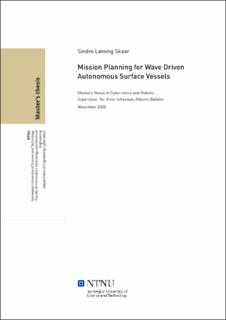| dc.contributor.advisor | Johansen, Tor Arne | |
| dc.contributor.advisor | Dallolio, Alberto | |
| dc.contributor.author | Skaar, Sindre Løining | |
| dc.date.accessioned | 2021-09-23T18:20:42Z | |
| dc.date.available | 2021-09-23T18:20:42Z | |
| dc.date.issued | 2020 | |
| dc.identifier | no.ntnu:inspera:66462738:20993257 | |
| dc.identifier.uri | https://hdl.handle.net/11250/2781010 | |
| dc.description.abstract | En økt bruk av autonome sjøfarende fartøy er forventet å drastisk forandre hvordan både mennesker, gods og forskning blir håndtert i fremtiden. Den økte kapabiliteten til autonome fartøy har gjort dem til et mer aktuelt alternativ. Fartøyene har også blitt rimeligere grunnet en reduksjon i pris på maskinvare og programvare. En reduksjon i størrelsen på mange viktige komponenter har også drastisk økt kapabilitetene til mindre fartøy, som tillater fartøyene å kunne bli brukt i en mye større skala innenfor både forskning og industri.
Institutt for Teknisk Kybernetikk hos NTNU, Trondheim, er involvert i utviklingen av et bredt spekter av fartøy fra dynamisk posisjonering av forsyningsfartøy til slangeroboter. NTNU er også involvert i forskning innen akvakultur for å øke forståelsen av hvordan norges utvikling innen havbruk og akvakultur påvirker sjøen og det biologiske mangfoldet. For å støtte forskningen utvikler NTNU selvforsynte autonome fartøy som kan utføre oppdrag som før var utført av ekspidisjonsfartøy på opptil 400 tonn. Små autonome fartøy har derimot fortsatt problemer med å navigere og holde seg unna farlige situasjoner i vanskelige værforhold. Manuelt planlagte oppdrag er ofte umulige for autonome fartøy å gjennomføre. For sterk strøm kan for eksempel føre fartøy hundrevis av kilometer ut av kurs, noe som kan føre til dyre redningsoppdrag eller tap av fartøyet.
Denne avhandlingen har fokusert på å øke kapabilitetene til mindre autonome fartøy og redusere sannsynligheten for at fartøyene ikke kan gjennomføre oppdragene sine. For å få til dette har en oppdragsplanlegger blitt utviklet som planlegger både rute og sensorbruk i hensyn til værforhold. Dette tillater algoritmen å finne en praktisk gjennomførbar rute og samtidig optimalisere den monetære kostnaden av oppdraget. For å kunne planlegge ruter til fartøyet tar avhandlingen også for seg en matematisk modell for å beskrive dynamikken til bølgedrevne fartøy. Dette gjør det mulig å kunne forutsi hvordan vær påvirker dynamikken. Denne modellen, sammen med en egenprodusert Binær-Kontinuerlig partikkel sverm optimalisering algoritme, ble brukt for å optimalisere den estimerte oppdragskostnaden.
Den matematiske modellen ble testet og tilpasset tester av et virkelig bølgedrevet fartøy kalt AutoNaut. Parameterestimeringer av modellen ble gjort både i nære kystområder i Trondheimsfjorden, skjermet for tungt vær, og ute i åpen sjø ved Mausund.
Ved å bruke optimaliseringsalgoritmen, klarte algoritmen å finne gjennomførbare ruter hvor den manuelle metoden ikke ville være gjennomførbar. Dette øker kapabiliteten under forhold som tidligere var for utfordrende. | |
| dc.description.abstract | Increased autonomy within the ocean vessel sector is expected to drastically change how both humans, goods and research is conducted in the coming future. Due to the increased capabilities of autonomous vehicles, they have become a more viable alternative. The vehicles have also gotten increasingly more affordable due to the reduced cost in both hardware and software. A reduction in size of many important components have also drastically increased the capabilities of smaller autonomous vessels, allowing a much broader adoption of the technology within research and the industrial sectors.
The Institute of Cybernetics and Robotics at NTNU, Trondheim is involved in the development of a broad spectre of autonomous seagoing vessels, spanning from dynamic positioning of large supply vessels to autonomous snake robots. NTNU is also involved in ocean sampling to further the understanding in aquaculture and the environmental impact of the future Norwegian development at sea. NTNU is developing self sufficient autonomous vessels capable of performing missions previously done by large and costly vessels closer to 400 tons. Small autonomous vessels still have problems navigating and staying safe in changing weather conditions. Manually planning missions often creates unfeasible missions not possible for the autonomous vessels to conduct. Too strong weather can displace small autonomous vessels hundreds of kilometres off course, leading to costly rescue missions or loss of the vessel.
This thesis has focused on increasing the capabilities of smaller autonomous vessels and reducing the chance of the vessel being carried off course. A mission planner has been developed that plans a vessel path and sensor sampling to take into account challenging weather. This allows the algorithm to create a path feasible for the vessel to conduct, while also optimising the monetary cost of the mission. To be able to predict feasible paths, the thesis has focused on finding a model for wave propelled surface vehicles to be able to better predict vessel dynamics and take account for how weather affects vessel movement. This model was then used in conjunction with a custom binary-continuous particle swarm optimisation algorithm to optimise the total estimated mission cost.
The model was tested and fitted to real life testing of a wave powered vessel called AutoNaut. Parameter estimations were conducted for both on shore locations shielded from the off shore environment and off shore environments to get a better understanding of model parameter validity.
Using the optimisation algorithm, the system was able to find feasible optimised paths where the manually created paths would not have been feasible, therefore drastically improving the vessel capabilities even in environments normally deemed too challenging for the vessel to complete. | |
| dc.language | | |
| dc.publisher | NTNU | |
| dc.title | Mission Planning for Wave Driven Autonomous Surface Vessels | |
| dc.type | Master thesis | |
